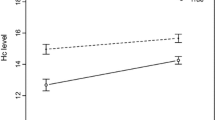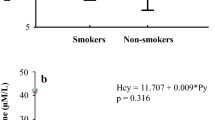Abstract
The role of hyperhomocysteinemia as a risk factor for diabetic long-term complications has not been sufficiently evaluated in prospective studies, considering specific correlates of homocysteine (tHcy) concentration and traditional cardiovascular disease (CVD) risk factors. Fasting tHcy, vitamin B12 and folate plasma levels, the common methylenetetrahydrofolate reductase (MTHFR) C677T gene polymorphism, as well as clinical and lifestyle information were assessed in 216 type 2 diabetic patients attending two outpatient clinics, who had a follow-up evaluation at 65 ± 9 months for the incidence of macroangiopathy. At basal evaluation, mild hyperhomocysteinemia (tHcy ≥ 15 μmol/l) was diagnosed in 21.3% of participants. At follow-up, hyperhomocysteinemia and the distribution of MTHFR C677T genotype did not significantly differ according to the incidence of macroangiopathy. Multiple variables adjusted ORs (95% CI) for CVD associated with mild hyperhomocysteinemia were 1.01 (0.37–2.82); P > 0.05; those associated with MTHFR TT genotype were 0.46 (0.15–1.38); P > 0.05. Although the prevalence of hyperhomocysteinemia was higher in diabetic men (26.9%) than in women (16.1%; P > 0.05), similar results were also observed in a separate sex-analysis. At the multivariate analysis, including in the model other potential CVD risk factors, only creatinine clearance was a significant risk factor for the development of macroangiopathy. In this cohort of diabetic subjects, mild hyperhomocysteinemia and the MTHFR TT genotype are not significant risk factors for the development of macroangiopathy; impaired renal function was confirmed as a significant predictor of this complication.
Similar content being viewed by others
References
Hoogeveen EK, Kostense PJ, Beks PJ, Mackaay AJ, Jakobs C, Bouter LM et al (1998) Hyperhomocysteinemia is associated with an increased risk of cardiovascular disease, especially in non-insulin-dependent diabetes mellitus: a population-based study. Arterioscler Thromb Vasc Biol 18:133–138
Elias AN, Eng S (2005) Homocysteine concentrations in patients with diabetes mellitus—relationship to microvascular and macrovascular disease. Diabetes Obes Metab 7:117–121
Audelin MC, Genest J Jr (2001) Homocysteine and cardiovascular disease in diabetes mellitus. Atherosclerosis 159:497–511
Jacques PF, Bostom AG, Wilson PW, Rich S, Rosenberg IH, Selhub J (2001) Determinants of plasma total homocysteine concentration in the Frammingham Offspring Cohort. Am J Clin Nutr 73:613–621
Frosst P, Blom HJ, Milos R, Goyette P, Sheppard CA, Matthews RG et al (1995) A candidate genetic risk factor for vascular disease: a common mutation at the methylenetetrahydrofolate reductase. Nat Genet 10:111–113
Klerk M, Verhoef P, Clarke R, Blom HJ, Kok FJ, Schouten EG, The MTHFR Studies Collaboration Group (2002) MTHFR 677 CT polymorphism and risk of coronary heart disease. JAMA 288:2023–2031
Russo GT, Di Benedetto A, Giorda C, Alessi E, Crisafulli G, Ientile R et al (2004) Correlates of total homocysteine plasma concentration in type 2 diabetes. Eur J Clin Invest 34:197–204
Passaro A, Calzoni F, Volpato S, Nora ED, Pareschi PL, Zamboni PF et al (2003) Effect of metabolic control on homocysteine levels in type 2 diabetic patients: a 3-year follow-up. J Intern Med 254:264–271
Hoogeven EK, Kostense PJ, Jakobs C (1997) Does metformin increase the serum total homocysteine level in NIDDM? J Int Med 242:389–394
Buysschaert M, Dramais AS, Wallemacq PE, Hermans MP (2000) Hyperhomocysteinemia in type 2 diabetes: relationship to macroangiopathy, nephropathy, and insulin resistance. Diabetes Care 23:1816–1822
The Expert Committee on the Diagnosis of Diabetes Mellitus (1997) Report of the expert committee on the diagnosis and classification of diabetes mellitus. Diabetes Care 20:1183–1197
Giorda CB, Avogaro A, Maggini M, Lombardo F, Mannucci E, Turco S, Diabetes and Informatics Study Group (2008) Recurrence of cardiovascular events in patients with type 2 diabetes: epidemiology and risk factors. Diabetes Care 31:2154–2159
The DAI Study Group (2004) Prevalence of coronary heart disease in a cohort of type 2 diabetic patients in Italy: the DAI study. Diabet Med 21:738–745
Rose GA, Blackburn H (1968) Cardiovascular survey methods. Monogr Ser World Health Organ 56:1–188
Welch GN, Loscalzo J (1998) Homocysteine and atherothrombosis. N Engl J Med 338:1042–1050
Ueland PM, Refsum H, Beresford SA, Vollset SE (2000) The controversy over homocysteine and cardiovascular risk. Am J Clin Nutr 72:324–332
Araki A, Sako Y, Ito H (1993) Plasma homocysteine concentrations in Japanese patients with non insulin-dependent diabetes mellitus: effect of parenteral methylcobalamin treatment. Atherosclerosis 103:149–157
Chico A, Perez A, Cordoba A, Arcelus R, Carreras G, De Leiva A et al (1998) Plasma homocysteine is related to albumin excretion rate in patients with diabetes mellitus: a new link between diabetic nephropathy and cardiovascular disease? Diabetologia 41:684–693
Hoogeveen EK, Kostense PJ, Jakobs C, Dekker JM, Nijpels G, Heine RJ et al (2000) Hyperhomocysteinemia increases risk of death, especially in type 2 diabetes: 5-year follow-up of the Hoorn study. Circulation 101:1506–1511
Soinio M, Marniemi J, Laakso M, Lehto S, Ronnemaa T (2004) Elevated plasma homocysteine level is an independent predictor of coronary heart disease events in patients with type 2 diabetes mellitus. Ann Intern Med 140:94–100
Ndrepepa G, Kastrati A, Braun S, Koch W, Kölling K, Mehilli J et al (2006) A prospective cohort study of predictive value of homocysteine in patients with type 2 diabetes and coronary artery disease. Clin Chim Acta 373:70–76
Selhub J (2006) The many facets of hyperhomocysteinemia: studies from the Framingham cohorts. J Nutr 136:1726S–1730S
Brattström L, Wilcken DEL (2000) Homocysteine and cardiovascular disease: cause or effect? Am J Clin Nutr 72:315–323
Passaro A, D’Elia K, Pareschi P, Calzoni F, Carantoni M, Fellin R et al (2000) Factors influencing plasma homocysteine levels in type 2 diabetes. Diabetes Care 23:420–421
Russo GT, Friso S, Jacques PF, Rogers G, Cucinotta D, Wilson PW et al (2003) Age and gender affect the relation between methylenetetrahydrofolate reductase C677T genotype and fasting plasma homocysteine concentrations in the Framingham Offspring Study cohort. J Nutr 133:3416–3421
Arai K, Yamasaki Y, Kaijmoto YY, Watada H, Umayahara Y, Kodama M et al (1997) Association of methylenetetrahydrofolate reductase gene polymorphism with carotid arterial wall thickening and myocardial infarction risk in NIDDM. Diabetes 46:2102–2104
Hasegawa G, Obayashi H, Kamiuchi K, Nakai M, Kanatsuna T, Yamaguchi M et al (2003) The association between end-stage diabetic nephropathy and methylenetetrahydrofolate reductase genotype with macroangiopathy in type2 diabetes mellitus. Exp Clin Endocrinol Diabetes 111:132–138
Sun J, Xu Y, Xue J, Zhu Y, Lu H (2005) Methylenetetrahydrofolate reductase polymorphism associated with susceptibility to coronary heart disease in Chinese type 2 diabetic patients. Mol Cell Endocrinol 229:95–101
Mazza A, Motti C, Nulli A, Pastore A, Andreotti F, Ammaturo V et al (1999) Serum homocysteine, MTHFR gene polymorphism, and carotid intimal-medial thickness in NIDDM subjects. J Thromb Thrombolysis 8:207–212
Scaglione L, Gambino R, Rolfo E, Lillaz E, Gai M, Cassader M et al (2002) Plasma homocysteine, methylenetetrahydrofolate reductase gene polymorphism and carotid intima-media thickness in Italian type 2 diabetic patients. Eur J Clin Invest 32:24–28
The Heart Outcomes Prevention Evaluation (HOPE) 2 Investigators (2006) Homocysteine lowering with folic acid and B vitamins in vascular disease. N Engl J Med 354:1567–1577
B-Vitamin Treatment Trialists’ Collaboration (2006) Homocysteine-lowering trials for prevention of cardiovascular events: a review of the design and power of the large randomized trials. Am Heart J 151:282–287
Avogaro A, Giorda C, Maggini M, Mannucci E, Raschetti R, Raschetti R, Raschetti R, Raschetti R, Lombardo F, Diabetes, Informatics Study Group, Association of Clinical Diabetologists, Istituto Superiore di Sanità (2007) Incidence of coronary heart disease in type 2 diabetic men and women: impact of microvascular complications, treatment, and geographic location. Diabetes Care 30:1241–1247
Cheng TY, Wen SF, Astor BC, Tao XG, Samet JM, Wen CP (2008) Mortality risks for all causes and cardiovascular diseases and reduced GFR in a middle-aged working population in Taiwan. Am J Kidney Dis 52:1051–1060
Conflict of interest statement
The authors state that they have no conflict of interest.
Author information
Authors and Affiliations
Corresponding author
Rights and permissions
About this article
Cite this article
Russo, G.T., Di Benedetto, A., Magazzù, D. et al. Mild hyperhomocysteinemia, C677T polymorphism on methylenetetrahydrofolate reductase gene and the risk of macroangiopathy in type 2 diabetes: a prospective study. Acta Diabetol 48, 95–101 (2011). https://doi.org/10.1007/s00592-009-0169-5
Received:
Accepted:
Published:
Issue Date:
DOI: https://doi.org/10.1007/s00592-009-0169-5




